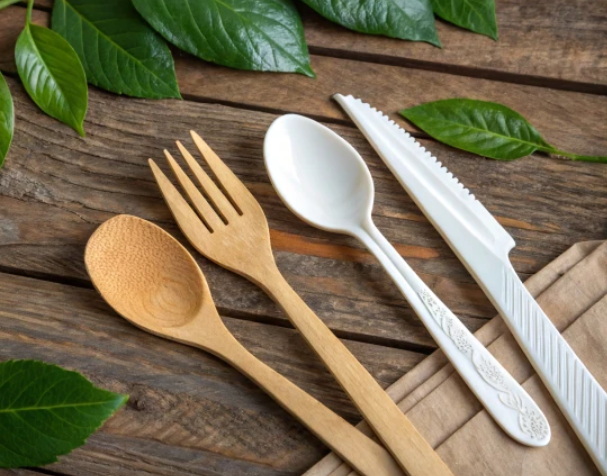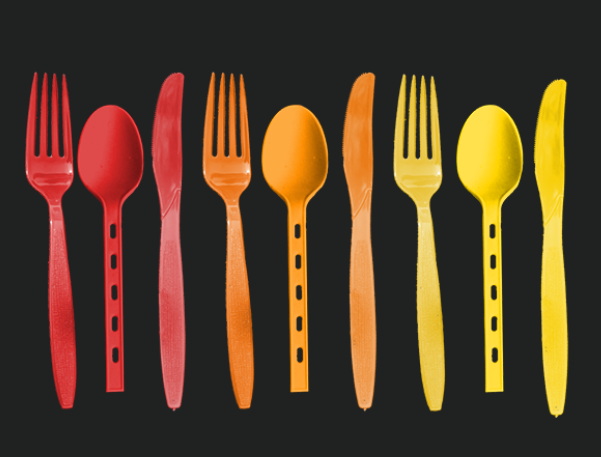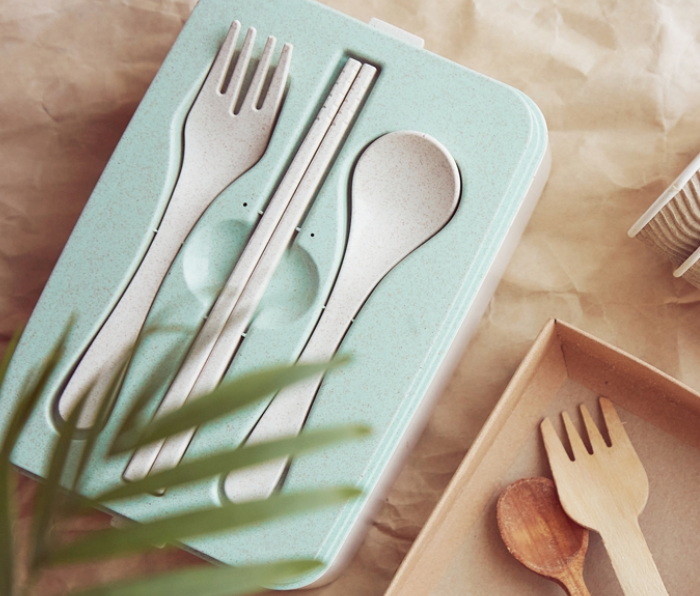
Content Menu
● What Is Non-Disposable Cutlery?
● The Environmental Impact of Disposable Cutlery
>> Waste Generation
>> Pollution and Resource Use
>> Biodegradable and Compostable Alternatives
● The Environmental Benefits of Non-Disposable Cutlery
>> Waste Reduction
>> Lower Greenhouse Gas Emissions
>> Conservation of Resources
>> Reduced Pollution
● Economic Considerations
>> Cost Savings Over Time
>> Maintenance and Replacement
● Practical Benefits of Non-Disposable Cutlery
>> Durability and Quality
>> Hygiene
>> Aesthetics and Customization
>> Portability
● Comparing Non-Disposable and Disposable Cutlery
● Challenges and Considerations
>> Water and Energy Use
>> Behavioral Change
>> Loss and Replacement
● The Role of Policy and Business
● Case Study: Schools Switching to Non-Disposable Cutlery
● The Future of Cutlery: Innovations and Trends
>> Material Innovations
>> Circular Economy Initiatives
>> Consumer Awareness
● Conclusion
● FAQ
>> 1. What materials are best for non-disposable cutlery?
>> 2. Does washing non-disposable cutlery use too much water or energy?
>> 3. Is non-disposable cutlery more expensive than disposable cutlery?
>> 4. Can non-disposable cutlery be used for takeout or on the go?
>> 5. How can businesses encourage the use of non-disposable cutlery?
● Citations:
The global conversation around sustainability has brought everyday choices into sharp focus, with single-use plastics—especially disposable cutlery—emerging as a major environmental concern. Each year, billions of plastic forks, knives, and spoons are discarded after just one use, clogging landfills, polluting waterways, and contributing to the growing crisis of microplastic contamination[2][10]. As a result, many individuals, businesses, and policymakers are turning their attention to non-disposable cutlery as a potential solution. But is non-disposable cutlery truly better for the environment? This article offers a comprehensive analysis, comparing the environmental, economic, and practical impacts of non-disposable cutlery versus its disposable counterparts.

What Is Non-Disposable Cutlery?
Non-disposable cutlery, often referred to as reusable cutlery, includes utensils made from durable materials such as stainless steel, bamboo, wood, or even high-quality recycled plastics. These utensils are designed for repeated use, requiring regular washing and maintenance, but offering years—or even decades—of service[1][3][9].
Key Types of Non-Disposable Cutlery:
- Stainless steel: Highly durable, corrosion-resistant, and widely used in homes and restaurants.
- Bamboo: Lightweight, biodegradable, and naturally antimicrobial.
- Wood: Renewable, compostable, and aesthetically pleasing.
- Recycled plastics: Made from post-consumer materials, offering a more sustainable plastic option.
The Environmental Impact of Disposable Cutlery
Waste Generation
Disposable cutlery, predominantly made from petroleum-based plastics, is designed for single use. Americans alone throw away an estimated 100 billion single-use utensils every year, which accumulate in landfills and natural environments[1][2]. Plastic cutlery is rarely recycled due to its small size and contamination with food waste, meaning most of it persists in the environment for centuries[2][4].
Pollution and Resource Use
- Microplastics: As plastic cutlery breaks down, it releases microplastics, which infiltrate waterways, soil, and even the food chain[2][10].
- Toxic Additives: Many plastic utensils contain chemicals like phthalates and BPA, which can leach into food and pose health risks[2].
- Resource Extraction: The production of disposable plastic cutlery relies on non-renewable fossil fuels, contributing to environmental degradation and greenhouse gas emissions[2][8].
Biodegradable and Compostable Alternatives
Some disposable cutlery is made from wood or compostable bioplastics. While these options are more sustainable, they still require energy and resources to produce and often need specific composting facilities to break down effectively[5][8].
The Environmental Benefits of Non-Disposable Cutlery
Waste Reduction
Switching to non-disposable cutlery dramatically reduces the volume of waste generated. For example, a school that replaced 700,000 plastic utensils with 12,000 metal reusable utensils prevented about 6,000 pounds of on-site solid waste in just one year[7]. Over time, this reduction compounds, keeping plastic out of landfills and oceans[1][9].
Lower Greenhouse Gas Emissions
Life cycle assessments show that metal utensils can reduce greenhouse gas emissions by up to 77% compared to disposable plastic utensils in the first year of use[7]. Over three years, these reductions can reach 88%, even when accounting for the energy and water used in washing[7].
Conservation of Resources
Non-disposable cutlery, particularly when made from renewable materials like bamboo or wood, conserves natural resources and minimizes the extraction of fossil fuels[3][8]. The longer lifespan of these utensils means fewer raw materials are needed over time.
Reduced Pollution
Reusable cutlery avoids the release of microplastics and toxic chemicals associated with disposable plastics[2][10]. Bamboo and wooden utensils are biodegradable, breaking down naturally without leaving harmful residues[3][4].
Economic Considerations
Cost Savings Over Time
While the upfront cost of non-disposable cutlery is higher, the long-term savings are substantial. Instead of continually purchasing disposable utensils, investing in a durable set of reusable cutlery can save money year after year[1][7]. For instance, schools that switched to reusable utensils saved an estimated $23,000 over three years[7].
Maintenance and Replacement
Non-disposable cutlery requires regular washing and occasional replacement due to loss or wear. However, these costs are generally outweighed by the savings from not purchasing disposables[7].

Practical Benefits of Non-Disposable Cutlery
Durability and Quality
Reusable cutlery is generally sturdier and more comfortable to use than disposable options. Stainless steel and bamboo utensils do not break easily and can handle a wide range of foods, including hot and dense dishes[1][3].
Hygiene
With non-disposable cutlery, users have control over cleaning and sanitation, reducing the risk of contamination from unknown sources[1]. Proper washing in hot, soapy water or a dishwasher ensures high hygiene standards.
Aesthetics and Customization
Non-disposable cutlery comes in various designs, materials, and colors, allowing for personal expression and a touch of style at the table[1][3].
Portability
Many reusable cutlery sets are designed for on-the-go use, often including a carrying case or pouch for convenience at work, school, or outdoor events[1][3].
Comparing Non-Disposable and Disposable Cutlery
| Feature | Non-Disposable Cutlery | Disposable Plastic Cutlery | Wooden/Compostable Disposable Cutlery |
| Waste Generation | Minimal (long lifespan) | High (single use, landfill) | Moderate (biodegradable, but still single use) |
| Greenhouse Gas Emissions | Low over lifecycle | High (production and disposal) | Moderate (production, composting) |
| Resource Use | Initial investment, then minimal | Continuous extraction of fossil fuels | Renewable (wood), but still requires energy |
| Pollution | None (if properly maintained) | Microplastics, toxic chemicals | Minimal (if composted properly) |
| Cost | Higher upfront, lower long-term | Low upfront, high long-term | Moderate to high |
| Durability | High | Low | Moderate |
| Hygiene | High (user-controlled) | Variable (factory packed) | Variable |
| Aesthetics | Customizable, stylish | Generic | Rustic, natural |
| Portability | High (with cases) | High | High |
Challenges and Considerations
Water and Energy Use
One concern with non-disposable cutlery is the water and energy required for washing. However, studies show that these impacts are minimal compared to the environmental benefits gained from waste and emissions reduction[7]. For example, the additional water used for washing reusable utensils is a "drop in the bucket" compared to the water saved by avoiding the production and disposal of disposables[7].
Behavioral Change
Adopting non-disposable cutlery requires a shift in habits, both for individuals and organizations. This includes remembering to carry reusable utensils, establishing washing routines, and overcoming the convenience of disposables[9].
Loss and Replacement
Reusable cutlery can be lost or misplaced, especially in public or institutional settings. Implementing systems for collection and replacement can help mitigate this issue[7].
The Role of Policy and Business
Governments and businesses play a critical role in encouraging the adoption of non-disposable cutlery. Policies such as bans on single-use plastics, incentives for reusable products, and public education campaigns can accelerate the transition to more sustainable practices[5][8].
Businesses, particularly in food service, can offer non-disposable cutlery for dine-in customers and incentivize customers to bring their own utensils for takeout[6][9]. Some establishments provide discounts or loyalty points for customers who use reusable cutlery, further promoting sustainable behavior.
Case Study: Schools Switching to Non-Disposable Cutlery
A comprehensive study in Minnesota evaluated the impact of replacing disposable plastic utensils with metal reusable cutlery in schools. The results were striking:
- Solid Waste Reduction: 6,000 pounds less waste generated in the first year.
- Greenhouse Gas Reduction: 77% lower emissions in the first year, 88% over three years.
- Cost Savings: $23,000 saved over three years.
- Negligible Impact on Water/Energy: Slight increase in water use for washing, but insignificant compared to overall benefits[7].
This case demonstrates that large-scale adoption of non-disposable cutlery is both environmentally and economically advantageous.
The Future of Cutlery: Innovations and Trends
Material Innovations
- Recycled Stainless Steel: Increasing use of recycled metals in cutlery manufacturing.
- Plant-Based Plastics: Development of durable, reusable plastics derived from renewable sources.
- Advanced Bamboo Processing: Improved durability and finish for bamboo utensils.
Circular Economy Initiatives
Businesses and communities are exploring circular models, where cutlery is collected, washed, and reused on a large scale, further reducing waste and maximizing resource efficiency[10].
Consumer Awareness
Growing awareness of environmental issues is driving demand for sustainable products, making non-disposable cutlery a popular choice among eco-conscious consumers[1][3][10].
Conclusion
Non-disposable cutlery is unequivocally better for the environment when compared to disposable alternatives. It significantly reduces waste, lowers greenhouse gas emissions, conserves resources, and prevents pollution from microplastics and toxic chemicals. While there are challenges related to washing, maintenance, and behavioral change, the long-term environmental and economic benefits far outweigh the drawbacks. By choosing non-disposable cutlery, individuals, businesses, and institutions can make a meaningful contribution to a cleaner, more sustainable future.

FAQ
1. What materials are best for non-disposable cutlery?
Stainless steel is the most durable and long-lasting option, while bamboo and wood are renewable, biodegradable, and lightweight. Recycled plastics can also be used for a more sustainable plastic alternative[1][3].
2. Does washing non-disposable cutlery use too much water or energy?
No. Studies show that the additional water and energy used for washing reusable cutlery are minimal compared to the environmental benefits gained from reducing waste and emissions[7].
3. Is non-disposable cutlery more expensive than disposable cutlery?
While the initial cost is higher, non-disposable cutlery saves money over time by eliminating the need for constant repurchasing. Schools and institutions have reported significant cost savings after switching to reusable utensils[1][7].
4. Can non-disposable cutlery be used for takeout or on the go?
Yes. Many reusable cutlery sets are designed for portability, often including carrying cases or pouches for convenience at work, school, or outdoor events[1][3].
5. How can businesses encourage the use of non-disposable cutlery?
Businesses can offer reusable cutlery for dine-in customers, provide incentives for customers who bring their own utensils, and participate in circular economy initiatives that collect, wash, and reuse cutlery on a large scale[6][9][10].
Citations:
[1] https://www.ahctgroup.co.uk/6-reasons-why-you-should-switch-to-reusable-cutlery
[2] https://refork.com/news/plastic-cutlery-vs-biodegradable-alternatives/
[3] https://friendlyturtle.com/blogs/blog/5-benefits-of-reusable-bamboo-cutlery
[4] https://www.magnumpackaging.co.uk/disposable-cutlery-faq-i27
[5] https://droppe.com/blog/article/how-to-choose-the-right-disposable-cutlery-for-food-service-a-buyers-guide/
[6] https://droppe.com/blog/article/disposable-vs-reusable-food-service-supplies-which-is-best-for-your-business/
[7] https://www.pca.state.mn.us/sites/default/files/p-p2s6-16.pdf
[8] https://droppe.com/blog/article/understanding-materials-plastic-wooden-and-compostable-disposable-cutlery/
[9] https://www.reusabletoronto.ca/faq
[10] https://ahimsahome.com/blogs/childrens-health-blog/the-surprising-impact-of-plastic-utensils-on-our-planet
[11] https://www.sciencedirect.com/science/article/abs/pii/S0921344922004487
[12] https://impactday.eu/blog/reusable-dishes/
[13] https://chuk.in/the-environmental-benefits-of-switching-to-compostable-tableware/
[14] https://growood.in/blog-detail/disposable-wooden-cutlery-vs-plastic-cutlery-quick-comparison
[15] https://eventableware.com/wooden-cutlery/
[16] https://www.anchenggy.com/blog/best-eco-friendly-cutlery-guide-disposable-and-non-disposable.html
[17] https://ch.duni.com/it/magazin/einwegbesteck
[18] https://thelivingco.com.au/blogs/news/reusable-cutlery-a-smart-choice-for-sustainable-living-and-on-the-go-convenience
[19] https://www.alder-tek.com/sustainability-of-wooden-utensils-the-environmental-benefits/
[20] https://www.hydepackage.com/info-detail/wooden-vs-plastic-cutlery-environmental-impact
[21] https://www.green-sapling.com/blogs/news/the-benefits-of-utilizing-eco-friendly-disposable-tableware-at-parties
[22] https://genaq.com/impact-plastic-cutlery/
[23] https://www.eui.eu/ServicesAndAdmin/LogisticsService/GreenEUI/FAQ/Plastic-Consumption/Question-1
[24] https://www.networx.com/article/disposable-vs-reusable-dishes-the-surpr
[25] https://www.bluecart.com/blog/sustainable-reusable-cutlery-restaurant
[26] https://www.thenationalnews.com/lifestyle/food/is-disposable-cutlery-mandatory-frequently-asked-questions-about-eating-at-uae-restaurants-1.1029438
[27] https://www.sulapac.com/blog/wooden-cutlery-pros-cons/
[28] https://www.easyngreen.com/eight-common-questions-about-ecofriendly-disposable-utensils.html
[29] https://info.lse.ac.uk/staff/divisions/estates-division/sustainable-lse/assets/documents/what-we-do/faq/faq-plastics.pdf
[30] https://delta.tudelft.nl/en/article/five-questions-about-tu-delft-cutlery-sets
[31] https://ediblecutlery.au/faqs/
[32] https://www.gov.il/en/pages/reusable-dishes
[33] https://www.anchenggy.com/blog/must-ask-questions-for-your-disposable-tableware-supplier.html
[34] https://polygonpapertech.com/future-of-paper-cutlery/
[35] https://cosmosecofriends.com/four-advantages-biodegradable-edible-cutlery/
[36] https://wonbonwood.com/disposable-wooden-cutlery-effectiveness/
[37] https://gmgreencity.com/single-use-plastics-questions-and-answers/
[38] https://foodstiks.com/pages/faqs
[39] https://gmgreencity.com/factsheet-takeaway-cutlery/

















